This easy cabbage kimchi recipe is easy to make and takes only 30 minutes of hands-on time before Mother Nature takes over! Video.
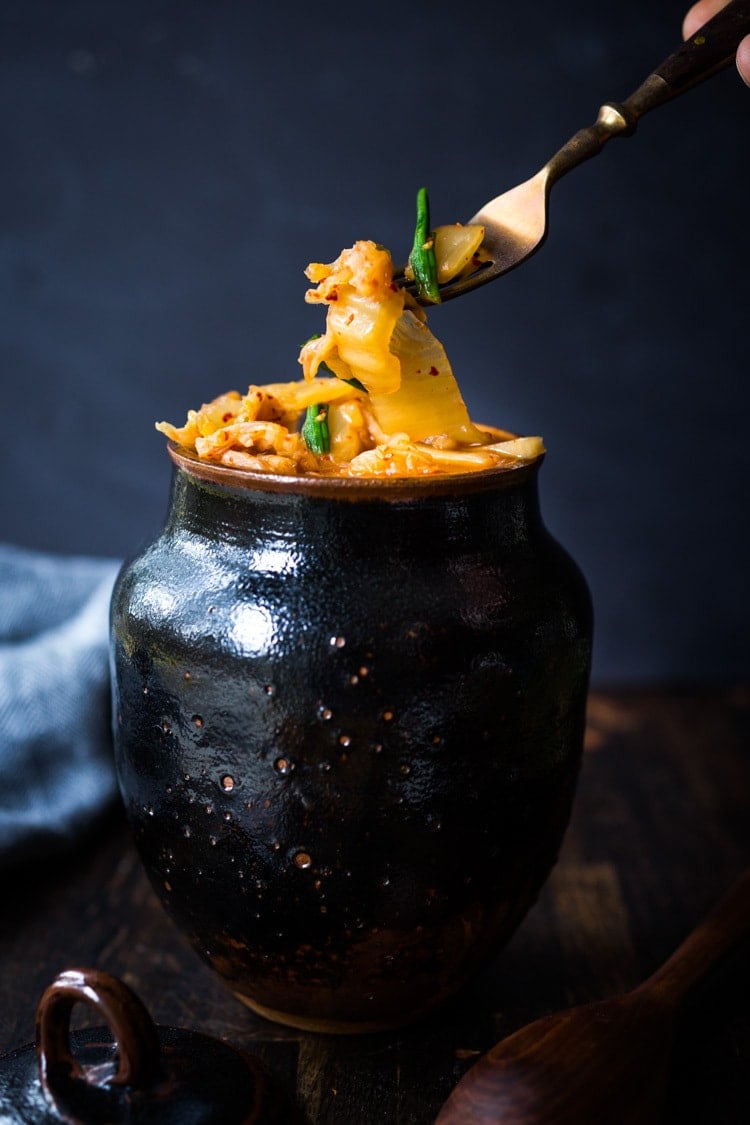
We are never in as much joy as when we are engaged in the well-being of others. ~ Adyashanti
With over 100 5-star reviews, this Kimchi Recipe is one of the most popular recipes on the blog. As a chef and caterer, I’ve made this kimchi dozens of times and have spent years simplifying this easy process so anyone can make it at home; it’s practically foolproof!
Many years ago now, we catered a Korean wedding. I remember meeting with the bride and groom and listening very carefully about the importance of the kimchi being served. It had to be “just right”.
The bride’s mother was kind enough to give me her family’s secret kimchi recipe, handed down for generations! After several attempts, I anxiously awaited her feedback.
Her reaction blew me out of the water. She loved it so much that she got teary and allowed me to share her family’s recipe here!
Kimchi is essentially fermented cabbage -similar to sauerkraut in how it is made, but using napa cabbage and seasoned with Korean spices: garlic, fish sauce, ginger & Korean chilies. Kimchi is the heart and soul of Korean cooking, and delicious with so many things!
Want to know the best thing about Kimchi? Kimchi is alive! Full of living, healthy, good bacteria or probiotics that support the gut, boost immunity, energize the body, and aid digestion, it is believed to fight cancer, lower cholesterol, and regulate blood sugar.
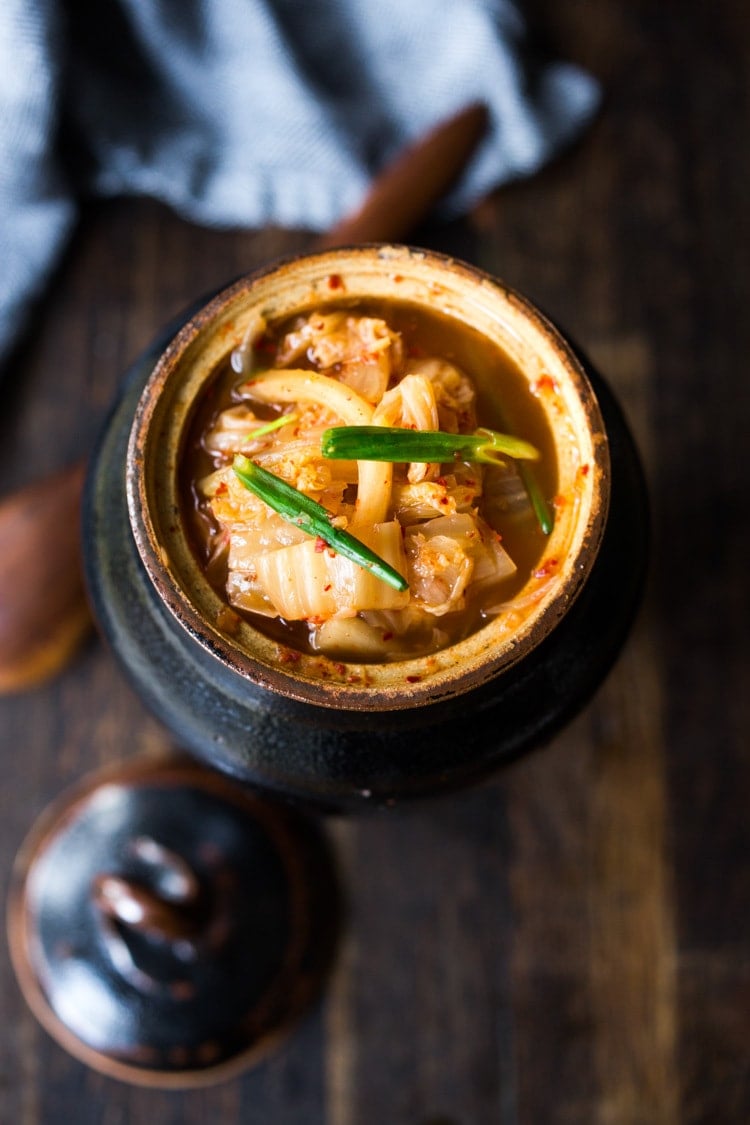
Why you’ll love this Easy Kimchi Recipe
- Simple ingredients. Familiar, whole-food ingredients like cabbage, spices, optional fish sauce, salt, dried Korean chilies, and sugar are called for here. Nothing processed!
- Vegan-adaptable. This recipe calls for fish sauce but can easily be made vegan. You can also leave out the sugar if you prefer.
- Incredibly nutritious! Kimchi is full of gut-healthy probiotics (specifically lactobacillus bacteria) that support a diverse gut microbiome. It also boosts the immune system, energizes the body, lowers cholesterol, and regulates blood sugar- along with so many other benefits!
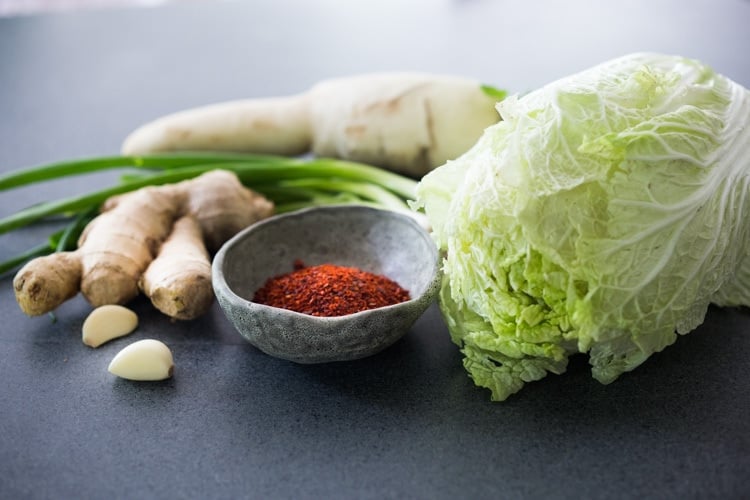
Kimchi Recipe Ingredients
- Napa Cabbage: This is the main ingredient and the heart of the recipe. Opt for organic or locally grown. Yes, you can substitute other cabbage, but Napa Cabbage is traditional.
- Fine Sea Salt– salt is key to fermenting, inhibiting bad bacteria growth while promoting good bacteria.
- Ginger: Adds a fragrant and subtly spicy taste.
- Garlic: Aromatic and pungent, garlic is key to enriching the flavor.
- Scallions (green onions): Brings in a bit of onion-like flavor, crunchy texture and color!
- Daikon: Subtly sweet and crunchy, daikon radish adds substance and texture.
- Fish Sauce, Shrimp paste, or Miso paste: Adds salt, umami, and depth of flavor. Shrimp paste is traditional, but fish sauce and miso (vegan option) both work too.
- Korean Chili Flakes: We use dried chili flakes (called Gochugaru)here for the purest, cleanest flavor(no preservatives, oils, or flavorings). Feel free to sub Gochujang paste if you prefer.
- Optional: Glutenous rice flour can be added to thicken.
- Equipment: An 8-cup mason jar and a fermentation weight are handy.
This easy kimchi recipe makes enough to fill a large two-quart jar (about 8 cups).
How to make Kimchi
*See the recipe card and video below!
Step one: Save 1-2 outer leaves of napa cabbage and place them in the fridge while you prep the recipe. (You will use these later). Using a cutting board, cut the napa cabbage into 1-inch cubes with a sharp knife.
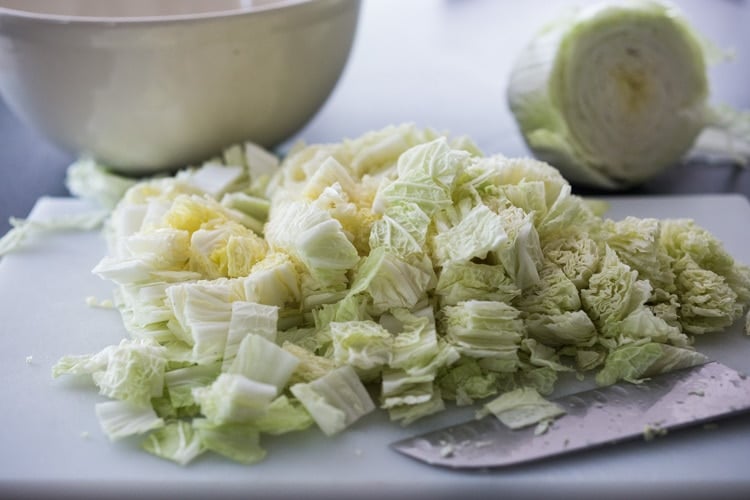
Step two: Place the chopped napa cabbage in a bowl and toss with 1/4 cup sea salt.
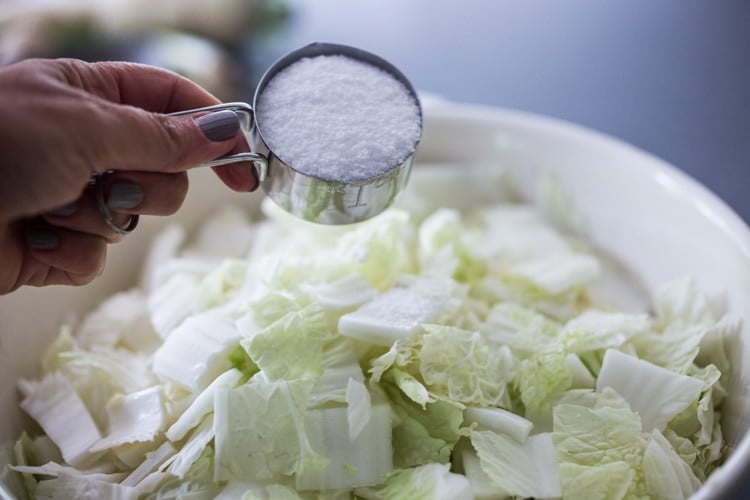
Step three: Fill the bowl with filtered water and stir, and soak the napa cabbage for 6-8 hours, stirring every couple hours.
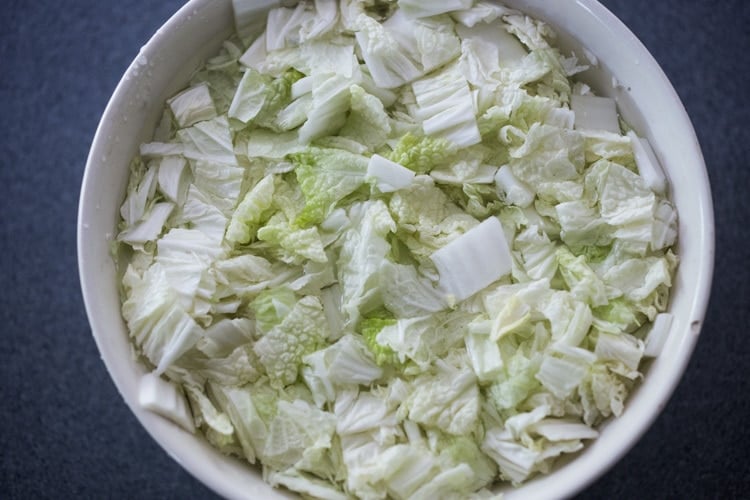
Place plate over the napa cabbage to keep it submerged.
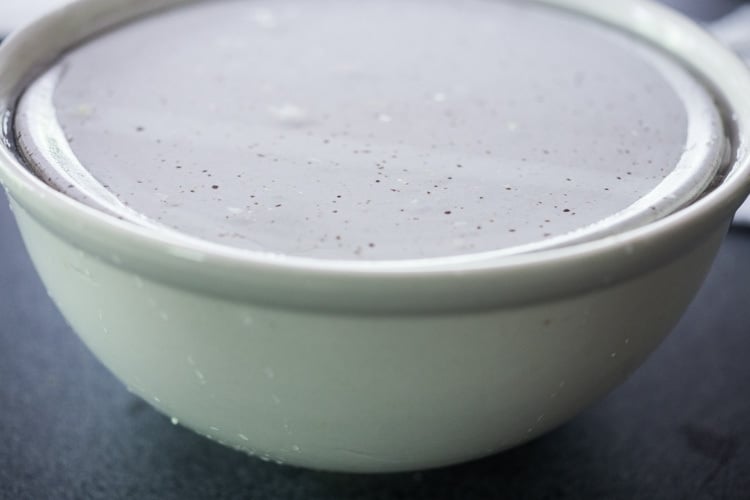
Step Four: After 6-8 hours, drain (making sure to save the brine) and rinse, pressing the liquid out.
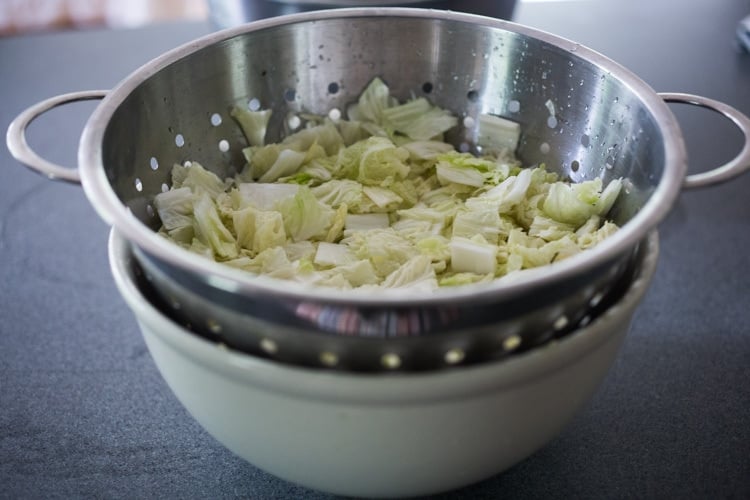
Step Five: Make the Kimchi Paste
As I stated earlier, I prefer to use Korean Chili Flakes called “Gochugaru” vs. the Korean fermented Chili Paste called “Gochujang”. Feel free to use Gochujang if you please. Totally up to you. Either way, you will make the paste below.
Many people ask if they can use regular old chili flakes- yes, but they are much spicier!!! Gochugaru is fruitier and less spicy, so you can use more and get more flavor. You could try subbing dried Arbol Chilies if you absolutely can’t get the Korean Chili flakes – or even use fresh red chilies to make the paste.
In a food processor, make a paste with garlic, ginger, shallot, Korean chili flakes (or Gochujang) and optional fish sauce (or miso) and sugar. If you want a mild version, use half the chili flakes. The fish sauce really adds a delicious complexity and depth, but you can, of course, keep it vegan with miso paste.
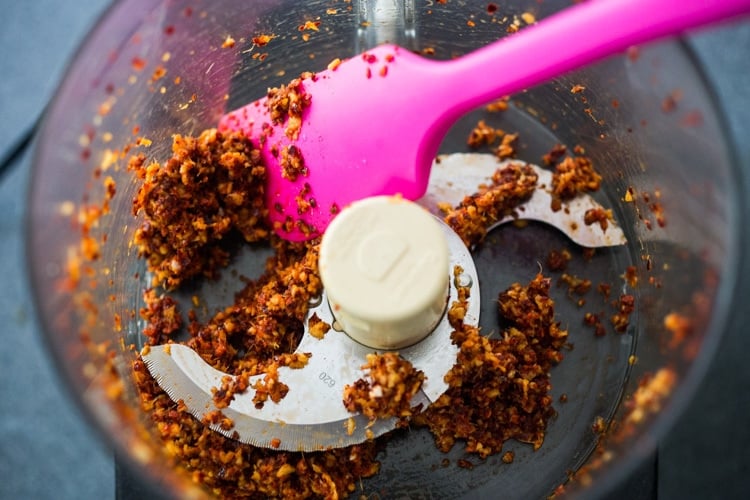
Step Six: Peel and cut the daikon radish (or carrots) into match sticks, about 2-3 inches long. Cut the scallions.
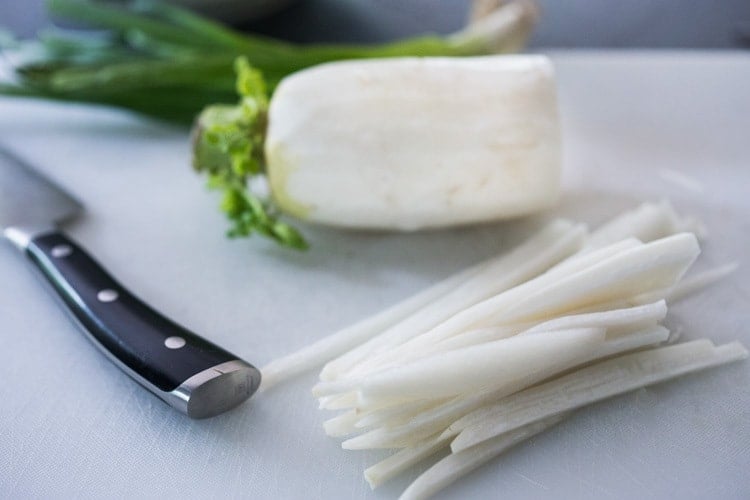
Step Seven: Cut the scallions into 1-2 inch pieces.
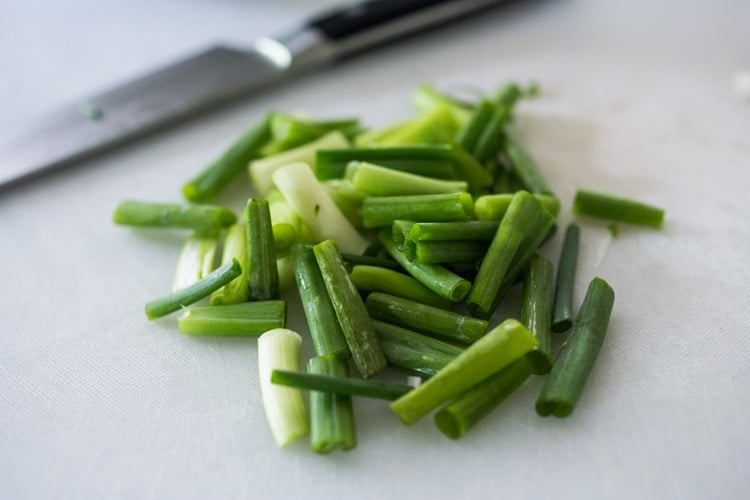
Step Eight: Combine the Kimchi. Place the drained cabbage along with the daikon, scallions and chili paste into the bowl. Massage the cabbage with gloved hands.
FYI: This is a very mild version shown below, so not very red in color, (2 tablespoons chili flakes). You can add more chili flakes if you want it spicier – I normally add 4-6 tablespoons.
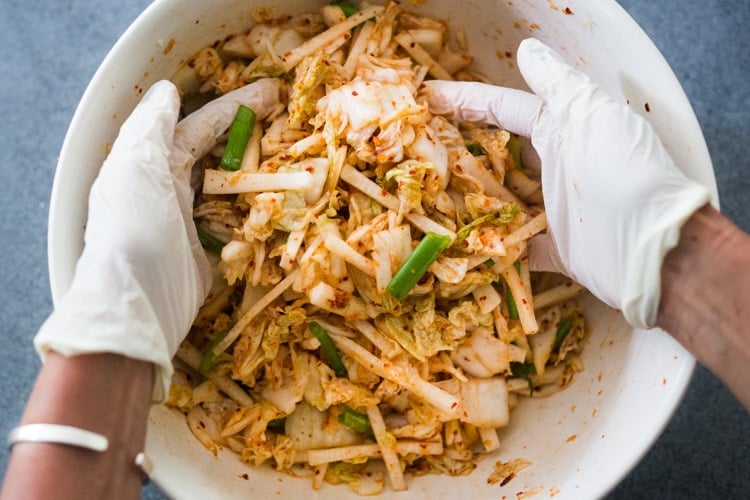
Step Nine: Pack the Kimchi.
Pack tightly into a large two-quart jar (half-gallon, 64 oz) or large crock. (Or use two, quart-sized mason jars.) You want a good two inches of space at the top to catch the flavorful liquid that will release.
TIP: I have had great success with this Fermentation Kit that has crystal weights that fit perfectly in a wide-mouth mason jar. It is so convenient for small-batch ferments. This fermentation kit includes the jars which is a great option too!
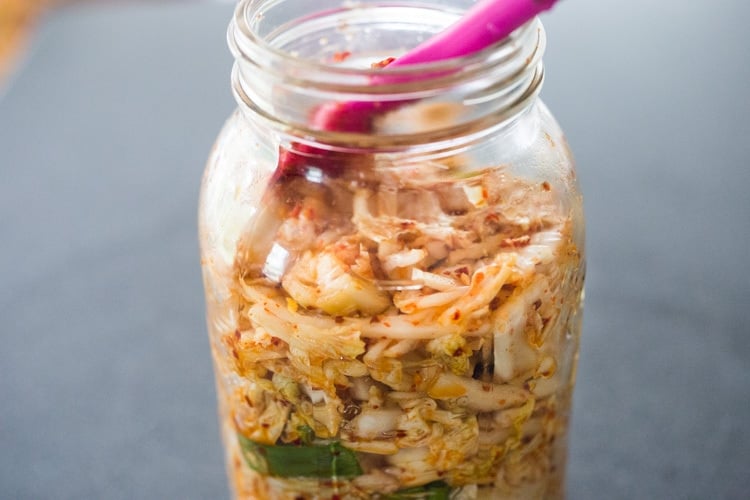
Cover with the cabbage leaf you saved in the fridge, and press down. Pour a little of the brine into the jar, just enough to cover the cabbage.
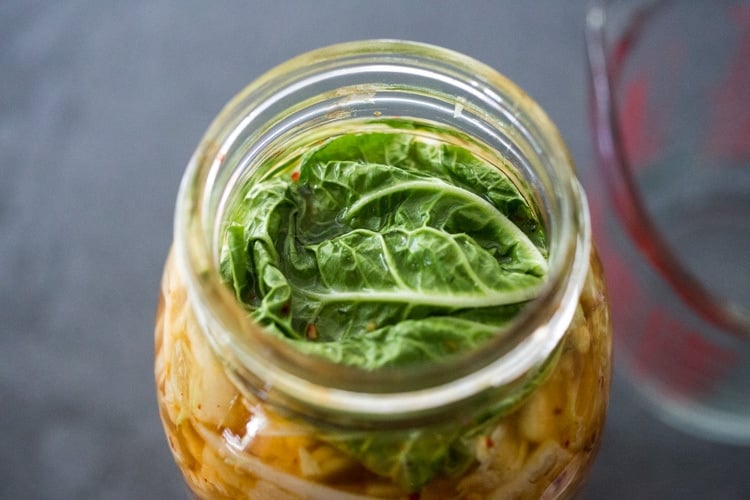
The cabbage leaf will help keep the chopped pieces of cabbage contained and submerged. Add a fermentation weight, pressing down to keep the cabbage leaf submerged under the brine. Anything that floats to the top and touches air can mold. So remove with a slotted spoon. Cover lightly with a lid (do not screw on tight) and place on a rimmed pan or bowl ( to collect any overflow).
Step Ten: Lacto-Fermentation
Set the jar somewhere dark and cool like the basement for 3-5 days. 60F-70F is ideal. Use a thermometer! A lower kitchen cabinet away from the stove or appliances can also be a cool spot. Fermentation happens faster in warmer climates and slows in cooler climates.
Check daily, pushing down the cabbage under the brine if need be and removing floaters. Remember, anything that touches air can mold.
After 2 days, the salt will have inhibited the bad bacteria enough to make more room for the good bacteria to feed on the cabbage and grow. As they “eat” the cabbage, they create gas and a tangy byproduct. This is how you know it is fermenting!
Kimchi Variations
Like so many things, there are so many variations to kimchi, and people have their own personal preferences. I just wanted to provide you with a starting point, and I’m sure you will adapt to your own tastes!
- Sugar is optional- some people add it, some don’t!
- Matchstick carrots would make a nice addition if you want more vegetables.
Probiotic Benefits of Kimchi!
There are so many reasons to consume fermented foods and probiotics daily, like this gut shot that contains strains of live probiotic cultures. Here are the benefits of consuming live active cultures:
- Improved Digestion: Probiotics can help maintain a healthy balance of gut bacteria, preventing dysbiosis or leaky gut. Probiotics aid in digestion and nutrient absorption. Read more.
- Enhanced Immunity: A healthy gut contributes to a strong immune system, and probiotics can help support this by promoting a balanced gut microbiome. Further information.
- Mental Health Support: Some studies suggest that probiotics may have a positive impact on mental health, potentially helping to reduce symptoms of anxiety and depression. Explore the study.
- Metabolic Health. Adding fermented foods to the diet can play a role in preventing and managing metabolic conditions, such as obesity and diabetes. The metabolites produced during fermentation can help regulate appetite and improve insulin sensitivity. Some fermented foods have been associated with better weight management.
- Cardiovascular Health. The bioactive peptides produced during the fermentation process have been recognized for their role in cardiovascular health. These substances can lower blood pressure and have anti-thrombotic properties, which are important in the prevention of heart disease. Check out the research.
How to use this Kimchi Recipe
We add napa cabbage kimchi to so many things! It is a huge flavor booster, and FULL of natural, gut-healing bacteria that support your microbiome, boost your mood, and bolster your immune system!
Here are a few of our favorite ways to use kimchi!
- Kimchi Fried Rice
- Kimchi Noodles
- Kimchi Burritos
- Kimchi Soup Recipe
- Seoul Bowl!
- On Buddha Bowls
- As a side dish with dinner, simply drizzled with toasted sesame oil and with a sprinkle of sesame seeds!
Storing Kimchi
Keep fermented kimchi in the refrigerator. Kimchi can not be made shelf-stable without killing the probiotics. Store in a 2-quart jar or crock with the lid on, pressing it down under the brine after each use. It will keep for months on end in the fridge when the kimchi is submerged below the brine….getting better and more flavorful with time!
Popular Ways to Serve Kimchi
- Make Kimchi Chili Mac and Cheese
- Try our Kimchi Noodles
- Kimchi Burritos!
- Kimchi Fried Rice
- Make our Vegan Bulgogi Bowl
- Serve with Korean Tofu Rice Bowls
- Alongside our Korean BBQ Chicken
Homemade Kimchi FAQs
The ideal temperature for fermenting kimchi is 65 degrees. 65 F is perfect! The cooler it is, the slower it will take to ferment. The warmer, the faster. The longer you ferment the tangier and softer the kimchi will get. I prefer slightly crunchy kimchi, so ideally, 3-5 days at 65F is my favorite! Going too much over 70 degrees can actually have negative effects on the flavor.
If your kimchi is too watery for your taste, you can thicken it. To thicken kimchi, stir in a little glutenous rice powder. Some traditional recipes also use soybean powder.
Kimchi tastes sour, tangy, salty, spicy, and pungent! It’s similar to sauerkraut in that it is fermented cabbage, but kimchi is packed with flavor, umami and a little (or a lot) of heat! The fermentation process is what gives kimchi its sour flavor.
Because kimchi is naturally fermented, it is full of healthy bacteria, good for the gut and good for immunity. But besides being a healthy thing to incorporate into our diets, Kimchi adds so much flavor to things we are already making at home!
1. After 3 days, tap the jar to see if any bubbles rise to the top; bubbles indicating that it is fermenting. If there is any overflow, this is also a good sign of fermentation.
2. Smell, or taste the kimchi for tanginess. If it tastes sour or tangy, this is a sign of fermentation. If it just tastes salty, it is not fermented. Let it it sit a few more days.
3. Continue to ferment for 2 to 3 more days. If you want it tangier or softer, ferment longer, and when satisfied, place it the fridge, keeping in mind it will continue to ferment and create lactic acid, albeit more slowly. It will develop more flavor and complexity over the next two weeks in the fridge, and the spice level will mellow with time!
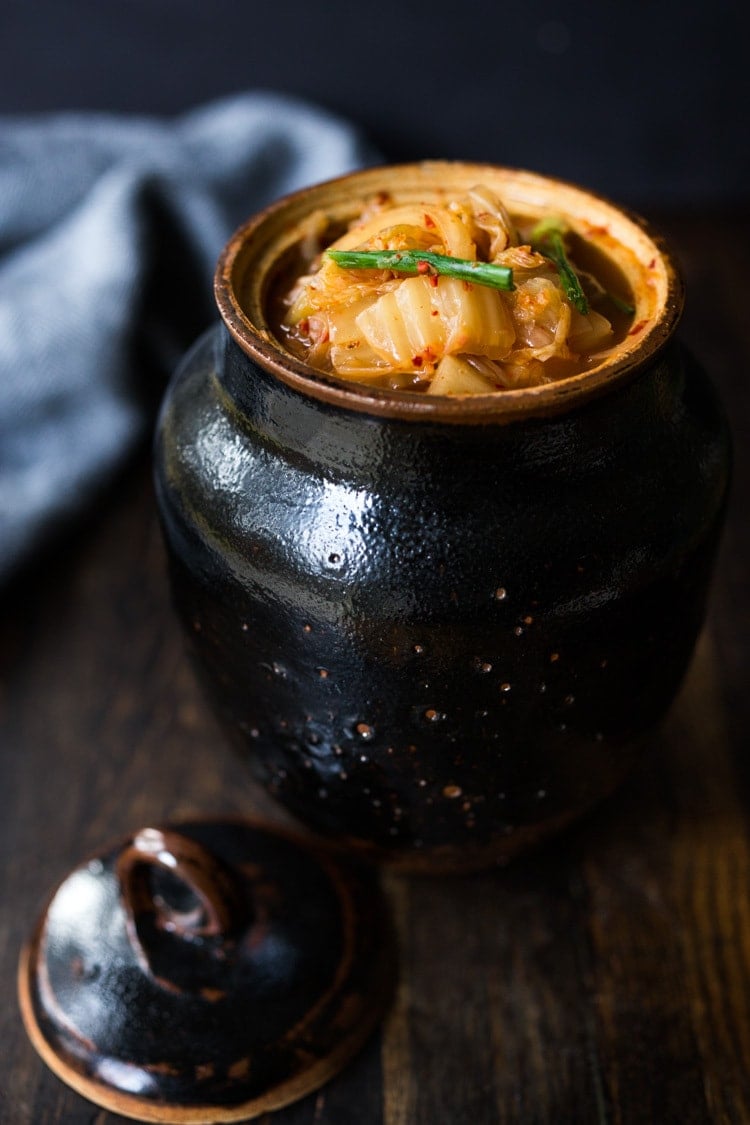
More Favorite Fermented Foods!
Enjoy the process of making Kimchi! Please ⭐️ rate the recipe (always appreciated) and tell us how it goes in the comments below.
xoxo
How to make Kimchi | step-by-step video
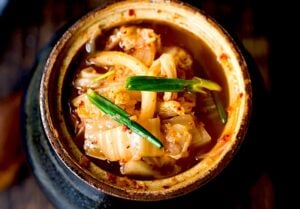
Homemade Kimchi
- Prep Time: 30 minutes
- Cook Time: 4 days
- Total Time: 72 hours 30 minutes
- Yield: 8 cups
- Category: fermented, sides, preserved
- Method: fermented
- Cuisine: Korean
- Diet: Vegan
Description
This easy Kimchi recipe is simple to make and takes only 30 minutes of hands-on time before Mother Nature takes over! Full of healthy, gut-healthy probiotics, this authentic kimchi is vegan-adaptable, gluten-free, and can be made as spicy or as mild as you like! Includes a video.
Ingredients
- 2 pounds napa cabbage, (large napa cabbage)
- 1/4 cup sea salt (60 grams)
- 2 cups daikon radish, cut into matchstick strips (optional, or use carrots)
- 1 bunch scallions, trimmed and cut into 1-inch pieces
- 1 tablespoon fresh ginger, sliced ( 2-3 disks, peels ok)
- 6 cloves garlic, whole
- 1 shallot, quartered (optional)
- 2-6 tablespoons Korean-style red pepper flakes (gochugaru) or sub gochujang – see notes!
- 2 tablespoons fish sauce (or use vegan fish sauce, shrimp paste, miso paste, or soy sauce), more to taste
- 2 teaspoons sugar ( or an alternative like honey, brown rice syrup)
- OPTIONAL:1 tablespoon glutenous rice powder (see notes)
Instructions
- SALT THE CABBAGE (6-8 hours): *Reserve 1-2 outer leaves of the napa cabbage and refrigerate for later use. Core and cut the remaining cabbage into 1-inch pieces and place in a large bowl with the salt and toss well. Add enough cool water to cover the cabbage and stir until salt is dissolved. Keep the cabbage submerged with a plate over the bowl and let this stand at room temperature 6-8 hours (giving a stir midway through if possible) or overnight.
- Drain the cabbage, saving the brine. Rinse the cabbage (not excessively, just a little quick rinse), drain, squeeze out any excess water, or blot with paper towels, and place it back in the bowl, adding the daikon radish and scallions.
- Make the PASTE: Place the ginger, garlic, shallot, red pepper flakes, fish sauce (or alternatives) and sugar in your food processor. Add optional rice powder (see notes!) Process until well combined, pulsing, until it becomes a thick paste.
- MASSAGE: Scoop the paste over the cabbage and using tongs or gloves, mix and massage the vegetables and the red pepper mixture together really well, until well coated.
- PACK the cabbage into a large, two-quart jar (or two, quart jars) or a crock, leaving 1-2 inches room at the top for juices to release. Add a little of the reserved brine to just cover the vegetables, pressing them down a bit ( so they are submerged) Place the whole cabbage leaf over top, pressing down- this should help keep the kimchi submerged under the brine. You can also use a fermentation weight placed over top of the whole leaf to keep it submerged. Or a small zip lock filled with water. Basically anything that touches air may mold – but no worries if this happens (see notes) it is not ruined.
- FERMENT (3-4 days) Cover loosely with a lid (allowing air to escape) and place the jar in a baking dish (or big bowl) to collect any juices that may escape. (The idea though, is to keep as much of the flavorful juice in the jar, so don’t overfill.) Leave this somewhere dark and cool (55F-65F is ideal) for 3 days. A basement or lower cooler cabinet in the pantry or kitchen away from appliances works best.
- EVENING OF DAY 3: Check for fermentation action or bubbles. Tap the jar and see if tiny bubbles rise to the top. Check for overflow (which also indicates fermentation). If you see bubbles, it is ready to store in the refrigerator where it will continue to ferment and develop more flavor slowly. For a softer tangier kimchi, you can continue to ferment for 3 more days or longer. If no action, give it another day or two. If you don’t see bubbles when tapping the jar, it just may need a couple more days- especially in cooler climates. Be patient. See the troubleshooting section below.
- REFRIGERATE: After you see bubbles (usually 3-5 days) the kimchi is ready, but it won’t achieve its full flavor and complexity, until about 2 weeks (in the fridge) slowly fermenting. The longer you ferment, the more complex and tangy the taste. If you like a fizzy brine, tighten the lid, burping every week or so. If you don’t want to think about it, give the lid one loose twist, so it’s on there, but gases can escape.
- Maintenance: This will keep for months on end in the fridge (as long as it is submerged in the brine) and will continue to ferment very slowly, getting more and more flavorful. Feel free to remove the cabbage leaf and just press kimchi down under the brine, after each use. ( See notes for adding more brine.)
- SERVE: Serve it as side dish: scoop it out using a slotted spoon, place in a small bowl, drizzle with sesame oil , toasted sesame seeds, and fresh scallions. Or Use it in Kimchi Fried Rice, Kimchi Burritos, Seoul Bowls, Kimchi Soup!
Notes
For milder kimchi, start with 2 tablespoons Korean chili flakes ( you can always stir in more). I like a spicy version with 6 tablespoons. 4 tablespoons is medium spicy.
If substituting with gochujang paste, add 2-6 tablespoons. You can always start conservatively and add more to taste after fermentation.
If you like your kimchi, thick, and less watery, you can use sweet glutenous rice powder to thicken. This is not the same as rice flour! Cook 1 tablespoon glutenous rice powder with ½ cup water, in a small pot over medium heat, stirring constantly until it boils. Let cool, still whisking occasionally. Add to the chili paste in the food processor. Continue with recipe.
BRINE If you need or want to add more salt brine to the kimchi, to keep it submerged, mix water and salt at this ratio: 1 cup water and 1 1/4 teaspoon fine sea salt. Stir it together first, pour over the kimchi.
TROUBLESHOOTING:
- MOLD If your cabbage leaf that is holding the kimchi down, happens to mold, just remove it, wipe out the rim of the jar as best you can, and replace it with a fresh one. Basically, if cabbage touches air here, it will mold, so after each use, press the kimchi down under the brine.
- NO BUBBLES: Check the temp of the kimchi using a kitchen thermometer. Ideally, you want this between 50-70F. 60-65 is best.
Nutrition
- Serving Size: ¼ cup
- Calories: 20
- Sugar: 1.6 g
- Sodium: 822.5 mg
- Fat: 0.2 g
- Saturated Fat: 0 g
- Carbohydrates: 3.9 g
- Fiber: 0.4 g
- Protein: 1.3 g
- Cholesterol: 0 mg
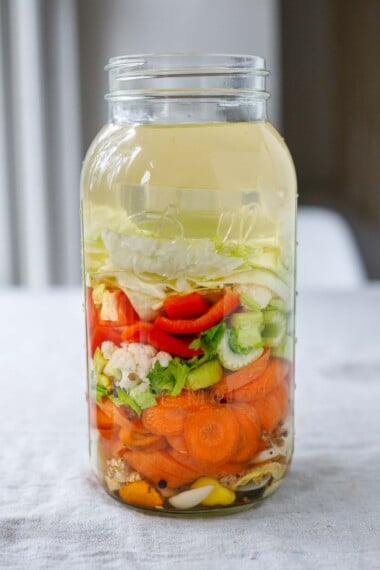
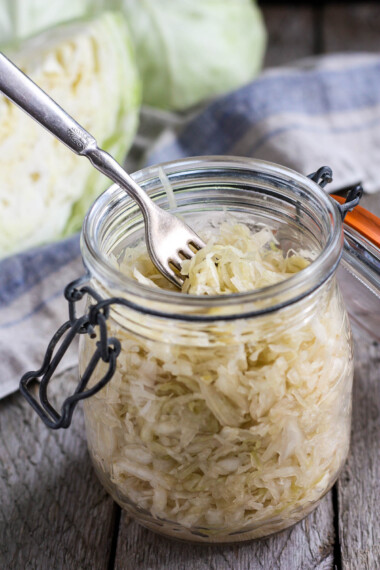
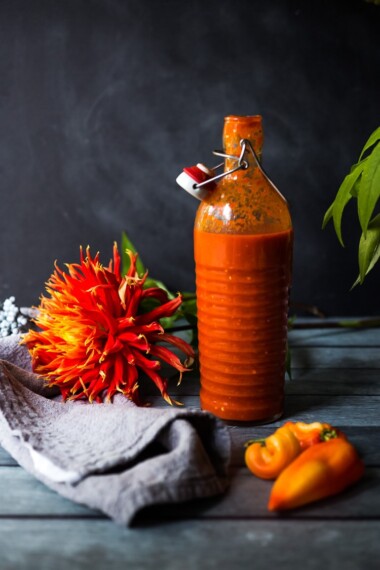
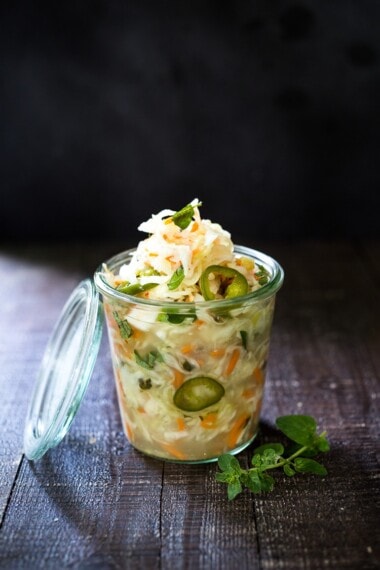
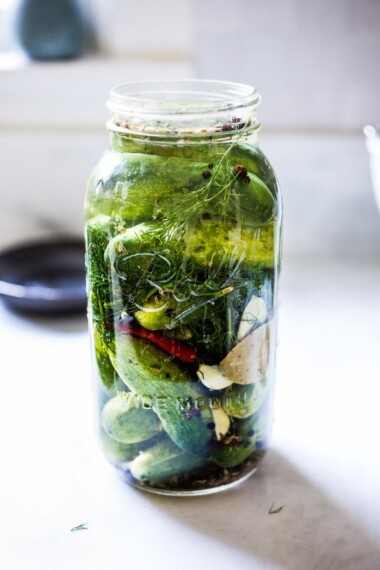
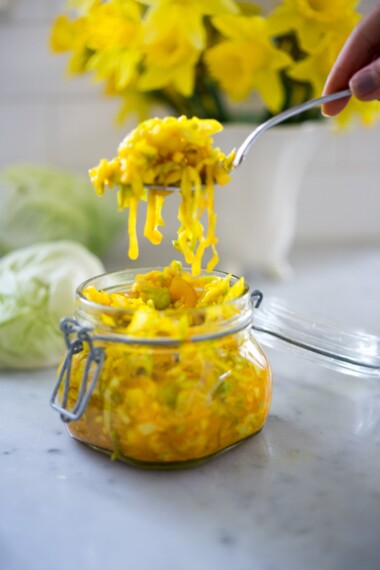
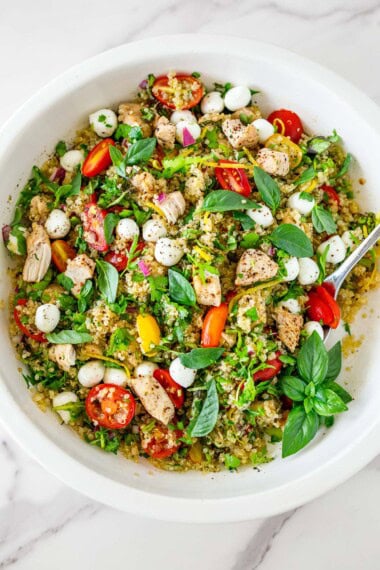
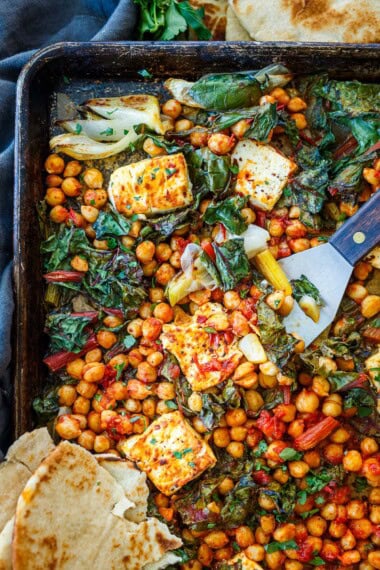
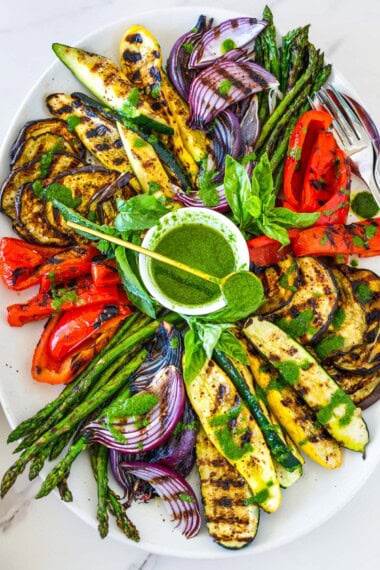




Excellent recipe! I’m on my second batch, I mowed through the first one during the confinement. I’m out of house jail so I headed down to my favo chinese market (which lies outside of our 1km limit so I couldn’t go there for two months!) to grab a massive cabbage and a daikon; salted, soaked, spiced and smelling fantastic. So easy and so very good. Thanks so much for posting this I just happened upon it a few short months ago and I’ve been sending peeps here ever since!
Thanks so much!
This looks yum I can’t have anything spicy is there any way I can make it without the chilli and anything that’s spicy in it?
Hey Karen- You could try making this without the chilies, yes, just season with the ginger and garlic.
Dear Sylvia, I have subscribed to your recipes, but now please help,I am going to make the Kimchi, I havn’t heard of Napa Cabbage in Australi we have all sorts, but can I use just the ordinary one (common cabbage) also today with a lot of searching found the gochugaru, but the bag is so huge it could feed a million, can I keep it in the freezer for when I need the rest of it? Thank you…….
Hi Margaret, I think most cabbage would work- napa cabbage feels like it has thinner leaves though. Yes, the dried chilies will last forever- no need to freeze, just wrap- or you can also substitute a smaller jar of the paste.
Napa cabbage is a chinese cabbage in Australia, it is everywere
So far so good. Smells right and looks right. Going through the process there were a couple items that I had to guess that I wasn’t sure of. First off is the strength of the brine. If you would specify the amount of water that should be used, then we could have a consistent ratio on our brine. As it stands, it could be anything from 2% to 30% depending on how much water you add. I imagine this will greatly affect not only the taste, but also how fast it will ferment. Second, and more minor is when we refrigerate, do we want to hard seal the lid? I looked into this further and it seems like if you want a more bubbly ferment, then close the lid tight and leave it alone for a couple weeks, but if you want a “flatter” ferment, then open the lid daily to let the CO2 escape. Other than that, I thought it was a great recipe and a good one for a first time kimchi effort (for me). Looking forward to munching.
OMG I am about to make this and wanted to know did you hard seal the lid when you put it in the fridge? and how was it?! Thanks!
I made this recipe but it didn’t ferment as in bubbles. I’ve had it in the fridge now for 3 weeks after previously sitting it in the bench for 3 days. It smells okay but no bubbles
is it tangy?
Does the kimchi bubble in the 3 days fermenting on the counter and do you keep the outer cabbage leaf on the top when you put it in the fridge?
Yes you should bubbles when you tap the jar. If it is cold it may take more time. I take off the outer cabbage leaf.
Excellent
It was such a simple recipe to follow and the ingredients required were available and affordable. I loved the spicy taste of it – cant wait for it to sit for as long as possible.
Also, I was curious about why in the picture the kimchi seems liquidy and not so red, whereas most Kimchi I’ve seen seems a lot more red in colour and more pasty vs liquidy. Is there a reason for that? I have yet to try it, but I will go for it as the comments seem to suggest it’s a good one!
Thank you!
I use the actual Korean flakes ( dried) here, which ferments along with the kimchi- not the gochujang paste is often filled with preservatives. Feel free to use the paste for that redder thicker look along with glutinous rice flour. ( See notes)
Hi! I don’t have a mason jar or jars with lids for storage in the fridge, can i just store it in a large bowl covered by a towel and plate as a ‘lid’?
thanks
Yes, you would still need something to weigh it down though.
I love that this recipe is totally from scratch ( not using the store bought Korean chili paste) because my family is highly sensitive to additives of any kind. This turned out perfect.
Hi, i really want to make this! Just wondering though, do you leave it on the counter for 3 days without closing the lid all 3 days? And then you close the lid when you out it in the fridge? 🙂
Just place the lid on top, don’t screw tight. Lightly screw it on to go in the fridge.
Thanks for the recipe! I just made it and after the three days there is a bit of mold at the top of my jars- can i simply remove the moldly parts? Or is the whole thing no good to eat now?
It will mold if cabbage touches the air. Yes discard the top, it should be fine underneath. Maybe after, pour it out, clean the jar and put back in?
Delicious, thank you for the recipe
Very good not Korea 1960 good but very good!
Thanks
Hi thanks for the recipe, I’m using Gochujang instead of gochugaru and was wondering how much to put in? Would it be equivalent to how much gochugaru you suggest?
Thanks
You can always it add to taste. Just add and taste, add and taste- to see how spicy you like it. The heat level will mellow slightly.
Nowhere in the recipe you mention anything about actually adding the sugar. That is a big fat fail making my kimchi not ferment, because the bacteria need sugar.
Thanks man. Great recipe. Had to throw everything in the trash.
Hi B- sorry you are frustrated. The sugar is added in step 3 of the instructions. But just to clarify- you don’t actually need to add sugar for things to ferment-think of sauerkraut and pickles, no sugar. So if your kraut didn’t ferment (which, are you sure it didn’t?) then it was probably due to something else.
Right there it is step 3
Please check before making any statements like above, and there are other ways of saying you were not happy with the recipe! The first time I made this I added far too much chili flakes (didn’t find Korean so don’t know what to compare it to) but now I have adjusted and the kimchi is delicious
Nice reading skills B!
I almost made the same mistake as B because I was following the step-by-step instructions with the pictures. While I was making it, I happened to scroll down to the recipe that’s in the square with the gray background and saw that I needed to add sugar!
I think B is right in saying that the sugar should be mentioned in both places. Not sure if that ruins the recipe or not, though!
Thanks so much Sophia for catching this! I now understand the confusion and fixed it in the photos. Mystery solved! Huge thanks!
Hi there,
I made this using your recipy but have a lot of liquid settling at the top, do you know if I can drain some of this off when it comes gto eating the Kimch or will this reduce the shelf life?
You want the brine to cover the cabbage while it’s being stored in the fridge, but feel free to strain the portion you are eating.
I made this recipe. Followed the amounts. It turned out well, however it is very salty, I am wondering if I can cut back on the salt the next time? I saw another recipe similar to this one but it used half the salt. I used the 6 table spoons of the paste and was a nice kick with out being too hot.
I’m wondering Dana if you rinsed the Cabbage after soaking in the saltwater brine?
Hi does it have to be nappa cabbage, or would york cabbage do? I’m more interested in the probiotics of this than the taste.
Any cabbage should work fine!
Hello
Stated to make Kimchi. There never seems to be enough liquid to cover the cabbage although I use some of the brine but I’m concerned that it gets too salty. Also, can you leave the leaf on top to submerge the cabbage, I’m worried it will go bad.
You need to submerge the cabbage leaf with something heavy (to prevent mold if in contact with air) – fermentation weights, a small ziplock bag filled with water, a clean smooth stone works too!
I don’t think using kochujang is ideal.
It’s a way to make this recipe from scratch. Less additives. 🙂
Hi thanks for the recipe!
My second batch is brewing even though the first one isn’t even done yet.
I am using fermenting caps on Maxon jars.
quite a bit of floaters (mainly Chile seeds or flakes) despite cabbage leaf and glass weight.
do I need to remove them? All the veggies are submerged.
thanks!
TJ
I think it should be fine!
Thanks for the fast response!!
It is awesome!!!
Welcome 🙂
Hi
I used this recipe as a base . In addition, I added celery, medium black radish, and shredded carrots. The paste I used 4 tablespoons gochugara, 1 tablespoon aldeppo pepper , 4 tablespoons ginger, 5 large garlic cloves, 2 tablespoons fish sauce , 4 tablespoons sesame oil, 2 tablespoons sesame seeds. Just finished and quick cheat taste I think it will be great.
This is the second time I’ve made this and I must say the ease surprised me. In the second batch I used the milder chili flakes (Korean) as I found the “heat” increases. The problem is that my family is on to me and begs a portion (it’s that good) so with my hubby and myself loving it, doesn’t last.
Haha, love it!